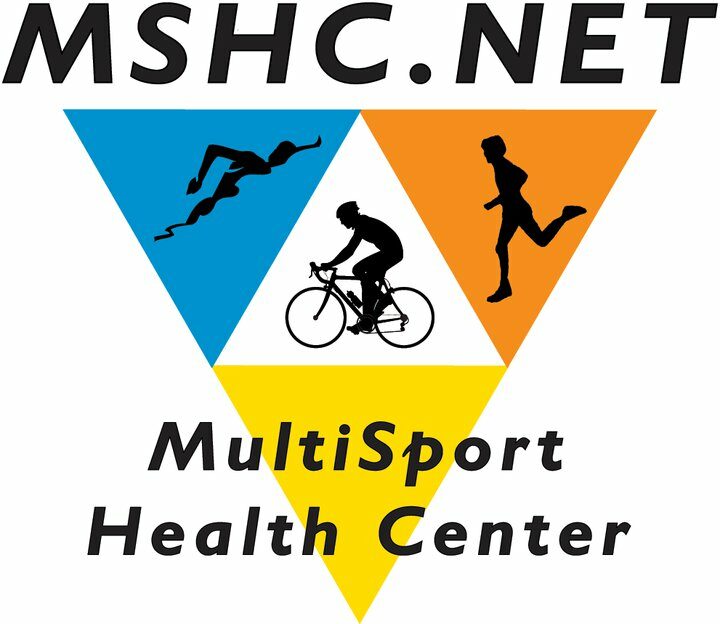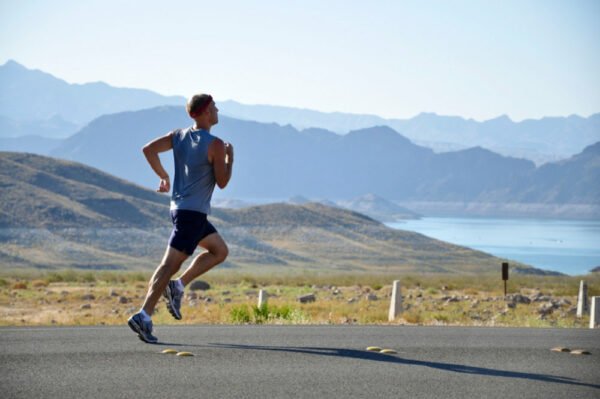 Ilio-Tibial band syndrome (ITBS) is the most common cause of lateral knee pain in runners and cyclists. It is recognized by the sharp, burning pain that feels almost as if you have a localized area of road rash from a bike crash. This friction is caused from the repetitive motion of the ITB sliding over the Lateral Femoral Epicondyle. The Iliotibial Band (ITB) is formed by the union of the Tensor Fasciae Latae, Gluteus Medius, Gluteus Maximus and Vastus Lateralis (See photo). It can also cause pain in the outer hip from Trocanteric Bursitis. This pain is due to the upper portion of the ITB sliding over the bony surface of the Greater Trocanter of the Femur. This condition can make it very difficult to sleep on the affected hip.
Ilio-Tibial band syndrome (ITBS) is the most common cause of lateral knee pain in runners and cyclists. It is recognized by the sharp, burning pain that feels almost as if you have a localized area of road rash from a bike crash. This friction is caused from the repetitive motion of the ITB sliding over the Lateral Femoral Epicondyle. The Iliotibial Band (ITB) is formed by the union of the Tensor Fasciae Latae, Gluteus Medius, Gluteus Maximus and Vastus Lateralis (See photo). It can also cause pain in the outer hip from Trocanteric Bursitis. This pain is due to the upper portion of the ITB sliding over the bony surface of the Greater Trocanter of the Femur. This condition can make it very difficult to sleep on the affected hip.
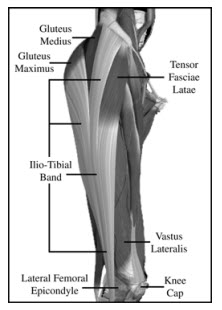 The function of the ITB is to assist in the stabilization and deceleration of the thigh during adduction, thus preventing the knee from collapsing inward toward the opposite leg. This condition most commonly affects athletes that are training only a little or excessively in only one sport. The inactive or slightly active population generally have weak Gluteal muscles due to lack of lateral movement or training. In cyclist, runners, and triathletes who train excessively, this condition occurs because all of their training is done in the same linear plane. This creates an imbalance of the muscles of the pelvic girdle. Due to the numerous hours spent running and/or cycling, some people choose not to cross train or lift weights. Others believe that weight lifting will make them big and bulky leading to injury or the loss of speed. In general, food makes you big and weight lifting like a body builder will make you big and slow. Properly lifting weights, using resistance tubing and stability equipment will enhance not hamper athletic performance.
The function of the ITB is to assist in the stabilization and deceleration of the thigh during adduction, thus preventing the knee from collapsing inward toward the opposite leg. This condition most commonly affects athletes that are training only a little or excessively in only one sport. The inactive or slightly active population generally have weak Gluteal muscles due to lack of lateral movement or training. In cyclist, runners, and triathletes who train excessively, this condition occurs because all of their training is done in the same linear plane. This creates an imbalance of the muscles of the pelvic girdle. Due to the numerous hours spent running and/or cycling, some people choose not to cross train or lift weights. Others believe that weight lifting will make them big and bulky leading to injury or the loss of speed. In general, food makes you big and weight lifting like a body builder will make you big and slow. Properly lifting weights, using resistance tubing and stability equipment will enhance not hamper athletic performance.
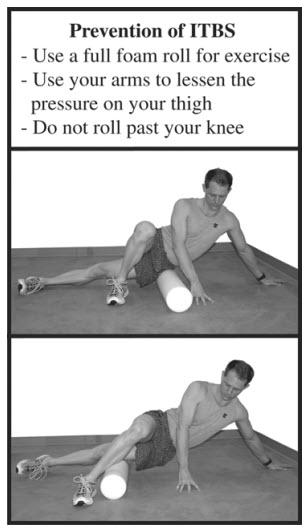
The acute phase of treatment should be focused on controlling inflammation and pain.
Running and all exacerbating movements should be avoided to prevent further injury and the continued delay of normal activities. Oral non-steroidal anti-inflammatory medications should only be used until the swelling is eliminated during everyday activities. Tylenol should be used for pain once there is no inflammation. Ice and Ultra Sound should also be used during this period. At this time, it is very important to find alternative activities for injured athletes. Some will be able perform exercises or handle treatment normally done in the recovery phase.
The recovery phase of treatment concentrates on some type of softtissue treatment, stretching exercises and non-weight bearing exercises.
During this phase employing a skilled practitioner is crucial. There are always fascial adhesions along the course of the ITB as it interacts with the muscles of the hip, thigh, and knee. The best soft-tissue method for relatively new injuries is Active Release Technique. For those cases that have been neglected or unsuccessfully treated for some time, the Graston Technique is great at breaking down chronic fibrosis. If you are unsure about your practitioners certification, ask for proof or contact the certifying organization.
A hard foam roll can be used at home as a means to preventing the ITB from becoming fibrous. You simply place the affected leg on the foam roll and gradually move from the top of the hip to the knee (See photo).
Stretching the ITB by itself is very hard to do and seldom successful.
You have to simultaneously stretch the ITB, the muscles of the hip and the lumbar spine. All stretching during the injury recovery phase should be done 3-5 times daily, holding each stretch for 30-60 seconds with no bouncing. You should stretch to the point of pleasant tension and should not reproduce the same pain as your injury. The following is a list of muscles that should be stretched: Tensor Fascia Lata, Gluteus (maximus, minimus and medius), Quadriceps, Hip Flexors, Hamstrings and Piriformis (See photo below)
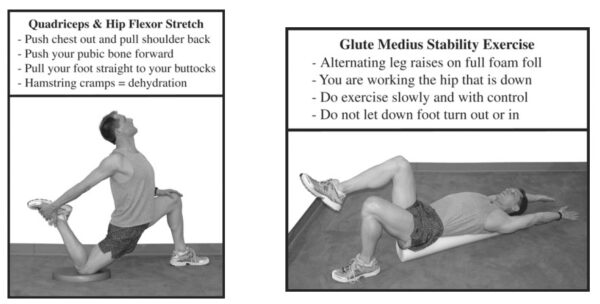
Non-weight bearing exercises are designed to strengthen the weakened muscles without forcing them to bear the entire body weight. If the muscles were strong enough for proper body weight exercises, there would never have been an injury. The following is a list of exercises that are effective for strengthening the aforementioned muscles:
- Side lying leg raises
- Gluteal stability training on a foam roller (See photo above)
- Scorpion with ankle weights
- Alternating arm and leg raises on/off a stability ball
- Hip extension and knee flexion with ankle weight
- Aqua jogging with a buoyance device
These exercises should begin with a number of repetitions that does not cause pain or 1 set of 20 reps and gradually progress to 3 set of 20 reps 3 days per week performed every other day.
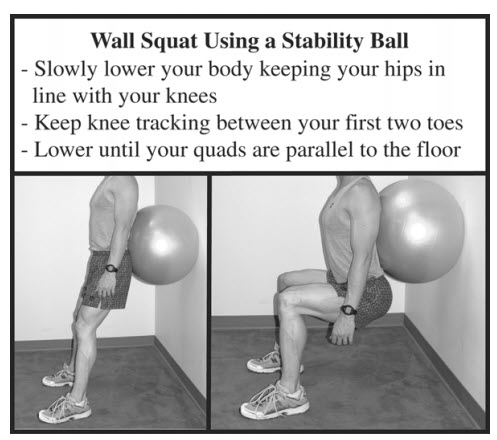 The rehabilitation phase of treatment is designed to progressively strengthen the muscles so that they are stronger than pre-injury status. This should allow the patient to run or cycle without pain or re-injury. The following exercises are all weight bearing and specifically designed to aid in running or cycling:
The rehabilitation phase of treatment is designed to progressively strengthen the muscles so that they are stronger than pre-injury status. This should allow the patient to run or cycle without pain or re-injury. The following exercises are all weight bearing and specifically designed to aid in running or cycling:
- Wall Squats with a ball (See photo)
- V-Lunges
- Step-ups
- Abduction and adduction with a theraband
- Hip extension with a theraband
- Gait training with a theraband
All weight bearing exercises should done 3 days per week, every other day beginning with 1 set of 20 repetitions and progressing to 3 sets of 20 reps.
You should only return to running after you are able to perform weight bearing exercises without pain for two weeks. Start by alternating short sprints and grapevine or karaoke exercises. Biomechanical studies have shown that faster running with its higher knee lift is less likely to aggravate ITBS. This is because at foot strike the knee is flexed beyond 30 degrees. Once you are running pain free again, the weight bearing exercises should be done 2 days per week for muscular balance and injury prevention.
Remember that the best way to prevent ITBS is to cross train and do stability training on a regular basis. The road to recovery for ITBS can be a long and painful one due to the fact that we continuously use the ITB when we walk, stand, and perform everyday activities. It is much better to take some time away from your running or cycling training to prevent ITBS than to not be able to run or cycle at all due to injury.
As previously printed in Houston Sports News
